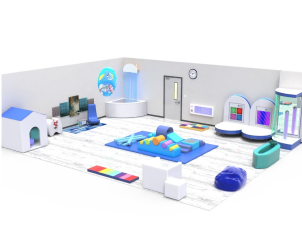Is your child a sensory seeker? If they seem to be constantly on the lookout for more sensory input and under-respond to available stimuli, then the answer is likely yes. It can be tough to keep up with this increased need for sensory stimulation. Although you may not feel up to the task, we have some great DIY tools you can use for your kids that you probably already have at home!
Great Activities for Sensory Seekers
First, let’s go through a few types of activities that will provide the extra sensory stimulation your kids need. For sensory seekers, we like to focus on providing more vestibular and proprioceptive input. This way they get a better sense of their bodies through a variety of sensations.
Playing on a jungle gym is a fantastic way for kids to expend energy and move in a variety of ways. Climbing, swinging, sliding, and using monkey bars all provide a range of proprioceptive stimuli to kids. If a jungle gym isn’t available, opt for smaller fidgets. We love using wiggle cushions or other alternative seating options to allow children to move while still focusing on the task at hand. Weighted blankets offer deep pressure input that helps calm your sensory seeker as well.
You may not always have a jungle gym or fidget tool available, but you likely do have these household items to give your kids.
1. Rocking chair
Gently rocking back and forth in a rocking chair provides similar vestibular input as kids get from a swing. Add some cushions or throw pillows to make it even more comfortable.
2. Shaving cream
Cover a plate or baking sheet with shaving cream and let kids use their hands to draw pictures and letters in the foamy cream. For an added textural component, add glitter or coarse salt to the mix and let kids explore the different sensations of each.
3. Paper or plastic cups
Work on motor planning skills by asking your kids to build a tower out of paper or plastic cups. They can practice different methods of building to figure out what works. Then let them knock it over with a ball or by rolling their body through it and restack before starting again!
4. Dried rice or beans
A pantry staple, these are also great for kids to play with. Fill a container halfway to create sound shakers. You can also pour the dried rice/beans into a long tube sock, tie it tightly shut, and use it as a weighted bean bag to toss up and down for some heavy work activity and coordination. These are also great to place in a shallow container to create a sensory bin. Hide pompoms or toy figures inside for kids to find.
5. Sponges and/or spray bottles
Turn bath time into a fun sensory activity by playing with spray bottles and sponges in the water. Hold the sponge underwater then let kids wring it out to work on fine motor skills. Kids can also practice hand-eye coordination by aiming the spray bottle at a spot on the wall and trying to shoot water at it.
6. Brown paper bags
Fill a paper bag with small items from around the house, from buttons to cotton balls to animal figurines. Have kids reach into the bag with their eyes closed and try to identify each item by touch. This is an easy way to explore tactile sensations as well as develop verbal descriptive and stereognosis skills.
Having the right tools for your kids’ sensory needs is important to their growth and development, but don’t get stumped if you don’t have something specific available to you!
Check out our favorite tools for sensory seekers.


























Comments